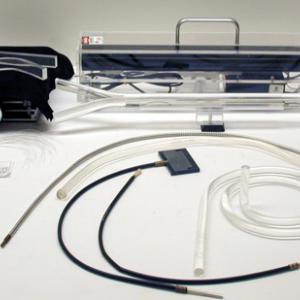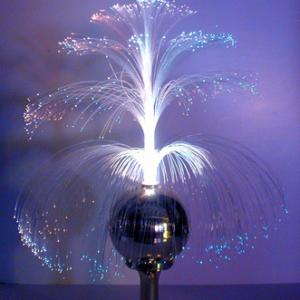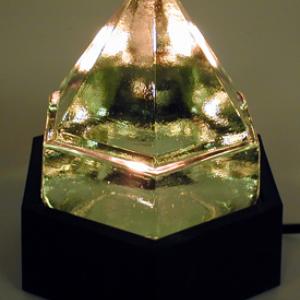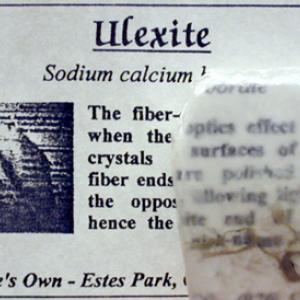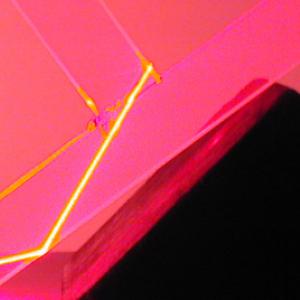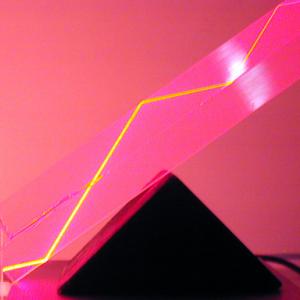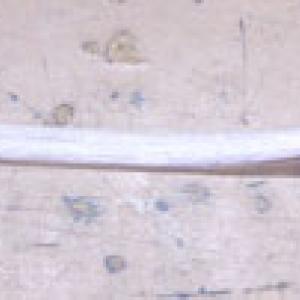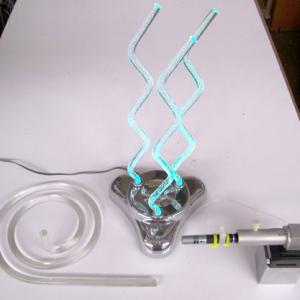College of Liberal Arts & Sciences
6A44.40 - Fiber Optics - Light Pipes & Single Mode Fiber
Use the laser as the light source to show the transmission properties of the light pipes. With the optical path demonstrator and a laser you can show the path of a light beam through a straight or curved light pipe. Put the beam expander onto the laser and shine this down the length of the Y - Rod light pipe. A screen may be used to show how the beam follows the rod. The homemade light pipes will have to be refilled with water periodically. This can be done easily with a disposable syringe and small needle.
The deck prism is a very primitive fiber optic conduit used primarily in sailing ships.
The ulexite is sometimes called "TV Rock". It is a natural fiber optics matrix made up of sodium calcium borate crystals in a tubular arrangement.
Two sets of fiber optics light pipes from the fiber optics demonstrator kit may be used to show some interesting effects. Wet the end of one of the light pipes with glycerin and press to the other light pipe at the position where the laser beam strikes the edge. The laser beam should be directed outside the first light pipe and into the second.
Be gentle with the single mode fiber so as not to break off the ends. Place the metal end into the laser adapter hole. When you turn on the laser, you shoudl see a very bright spot on the other end of the fiber.
- Yaakov Kraftmakher, "Telemetry with an Optical Fiber Revisited: An Alternative Strategy", TPT, Vol. 52, #7, Oct. 2014, p. 431.
- P. J. Ouseph, "Colgate-Plus" - An Imperfect Light Pipe", TPT, Vol. 31, # 6, Oct. 1993, p. 405.
- Ellen Schmidt, "Laser Light Gets Everyone's Attention", TPT, Vol. 27, # 1, Jan. 1989, p. 30.
- Dale Edgar, "Simulating Optical Fibers", TPT, Vol. 26, # 8, p. 504, November 1988.
- J. Hellemans, "A Simple Demonstration of the Total Internal Reflection in Fibers", TPT, Vol. 22, # 9, Dec. 1984, p. 589.
- Matt Young, "Optical Communication", TPT, Vol. 11, # 6, Sept. 1973, p. 353.
- Tom A. Kuusela, "Data Transmission in a Multimode Optical Fiber Using a Neural Network", AJP, Vol. 90, #12, Dec. 2022, p. 940.
- Od-2, 3, Oe-1, 7: Freier and Anderson, A Demonstration Handbook for Physics.
- O-255: "Fiber Optics - Rod, Ball, & Cyl", DICK and Physics Demo Notebook.
- "Photonic Fabric", Physics Today, Oct. 2008, p. 108.
- Martin C. Sagendorf, "Total Internal Reflection in a Fiber Optic Cable", Physics Demonstration Apparatus, 2009. p. 96.
- Mark Davids, et al., "Analog vs. Digital Methods of Transmitting Information", Teaching about Lightwave Communications, 1994, p. 3-27.
- Mark Davids, et al., "Manufacturing Fibers", Teaching about Lightwave Communications, 1994, p. 3-23.
- Mark Davids, et al., "Low-Loss Glass Fiber Guides for Transmission of Light", Teaching about Lightwave Communications, 1994, p. 3-15.
- Mark Davids, et al., "Pulse-Code Modulation", Teaching about Lightwave Communications, 1994, p. 3-28.
- Julien Clinton Sprott, "6.5, Spiral Light Guide", Physics Demonstrations, p. 242, ISBN 0-299-21580-6.
- "Fiber Optics: Carrying Sounds on Light Beams", Reader Digest: How in the World, p. 228 - 229.
- John H. Moore, Christopher C. Davis, Michael A. Coplan, "Fiber Optics", Building Scientific Apparatus 2nd Edition, p. 168-175.
- Robert E. Iannini, "Fiberoptic Communication", Build Your Own Working Fiber Optics, Infrared and Laser Space-Age Projects, p. 63-77.
- Robert Ehrlich, "TV Rock", Turning the World Inside Out, p. 180.
- Brian Jones and Matt Fackelman, "Light Pipe", Don't Forget the Duct Tape, p. 73 - 76.
- Curt Suplee, "Making light speak", Everyday Science Explained, National Geographic, p. 118.
- W. Bolton, "Light Guides", Book 2 - Waves and Particles, Physics Experiments and Projects, 1968, p. 76-78.
Disclaimer: These demonstrations are provided only for illustrative use by persons affiliated with The University of Iowa and only under the direction of a trained instructor or physicist. The University of Iowa is not responsible for demonstrations performed by those using their own equipment or who choose to use this reference material for their own purpose. The demonstrations included here are within the public domain and can be found in materials contained in libraries, bookstores, and through electronic sources. Performing all or any portion of any of these demonstrations, with or without revisions not depicted here entails inherent risks. These risks include, without limitation, bodily injury (and possibly death), including risks to health that may be temporary or permanent and that may exacerbate a pre-existing medical condition; and property loss or damage. Anyone performing any part of these demonstrations, even with revisions, knowingly and voluntarily assumes all risks associated with them.
